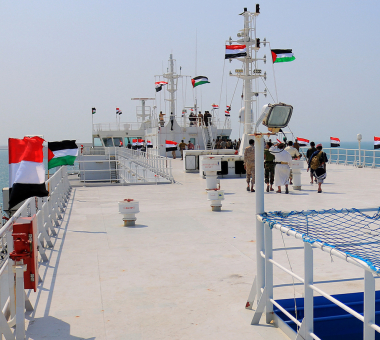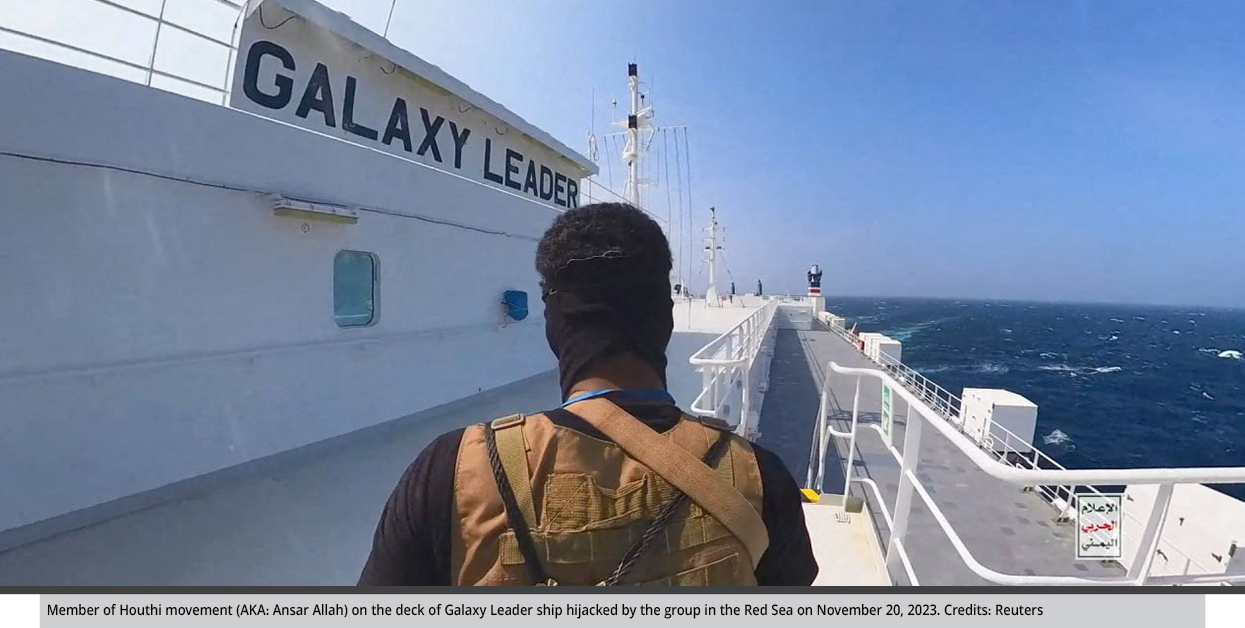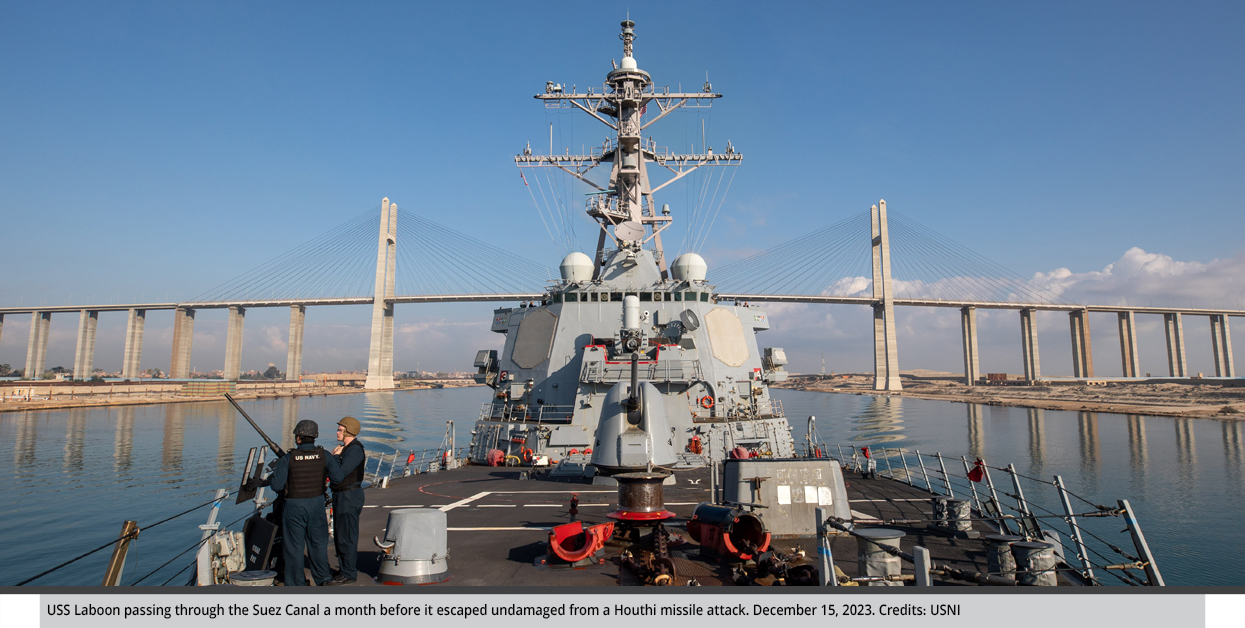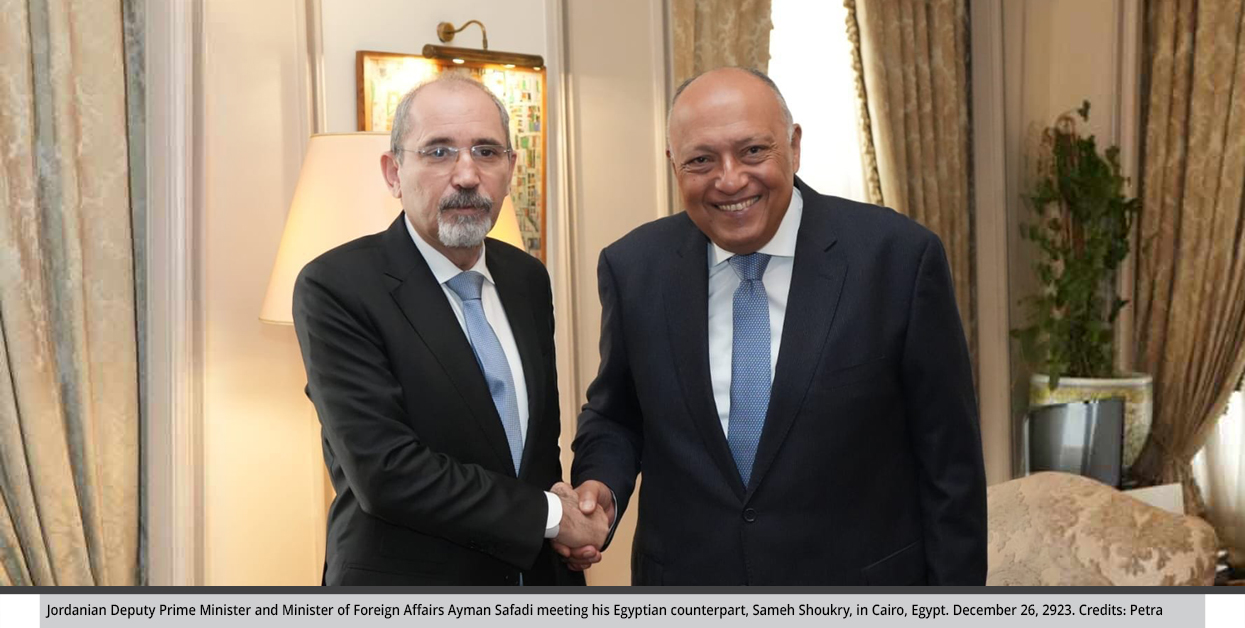The Escalation of Houthis and the Repercussions on the Region
This policy analysis addresses the escalation of the Houthi attacks in the Red Sea and its effects on Arab countries. This analysis also touches on the Operation Prosperity Guardian coalition launched by the United States with the participation of more than 20 countries to protect international shipping lanes.
by Hazem Salem Dmour
- Release Date – Jan 10, 2024

The Houthis in Yemen are escalating their attacks against Israeli territory and interests, from targeting the Israeli post city of Eilat to attacking commercial ships affiliated with Israel in the Red Sea.
In December, the Houthis carried out more than 100 drone and missile attacks against 10 commercial ships. Additionally, there were attacks against U.S. warships, prompting 18 shipping companies, including major international ones, as well as 55 ships between November 19 to December 17, to avoid Red Sea routes by rerouting around Africa’s Cape of Good Hope. In response, on December 19, the United States launched an international Operation Prosperity Guardian coalition to protect international shipping lanes.
Meanwhile, some Arab countries, specifically Jordan, Egypt, and the Gulf states, will find themselves facing more repercussions and damages caused by the war. With no indication that the Houthis plan to de-escalate their aggression, it’s logical to assume that political, economic, and security risks for the region are looming.
Houthi Attacks: Interests and Demands
Since 2011, the Houthis seized large swathes of northern Yemen before capturing the capital city of Sanaa. Since then, largely through the direct support of Iran and Lebanese Hezbollah, the Houthis have significantly improved their military capabilities, especially naval, by acquiring an arsenal of long-range missile systems, drones, anti-ship missiles, and boats. The Houthi arsenal includes guided maritime interception systems with sensors and sea mines, the Toufan (Typhoon) ballistic missile with a range of 1900 km, Quds-2 missiles with a range of 2000 km, and Samad drones with a range of 2,000 km.
According to Western officials, Iranian support for the Houthi attacks against ships related to Israel is continuing. The Houthis do not have radars to monitor ships, and many ships turn off their communication devices as soon as they pass through the Bab al-Mandab Strait. Tehran, however, provides the Houthis with intel through a ship stationed in the Red Sea that directs missiles and drones to their targets.

In fact, the Houthis are involved in Iran’s Unity of Arenas strategy and its informal anti-Israeli and anti-Western political and military coalition dubbed the Axis of Resistance. Although Houthi involvement has not make a difference in Israel’s war in Gaza, the Houthi movement has complex interests in it. Certainly the Houthis have proven their influence far beyond their military and political size. It seeks to enhance its image locally by adopting a hostile stance against the United States and Israel. And it is trying by any means necessary to enhance its gains against its local opponents as well as in any talks that may take place in the future concerning solving the crisis in Yemen.
One example is their proven threat to international trade in one of the most vital maritime straits and strategic ship-crowded zones in Bab al-Mandab, through which passes 12 percent of global trade and about 8 percent of global petroleum supplies. This prompted Western countries to open channels of communication with the Houthis. Japan, for instance, announced that it held talks after a Japanese-operated vessel was hijacked.
Although Houthi attacks did not halt the war in Gaza, they hurt the Israeli economy by restricting trade movement to Israel through the Red Sea and the port of Eilat. The port’s activity declined by 85 percent in the last 10 days of December due to Houthi attacks, announced Gideon Gulber, the port’s chief executive. In addition, the alternative route for trade movement through the Cape of Good Hope bloats transportation timetables by more than two weeks, not to mention the added costs on shipping.
Naval Attacks and the Looming Regional Escalation
The continuation of the Houthi attacks has produced direct repercussions and tangible damage in both regional security and global trade. The West and Israel have responded with an increased military presence in the Red Sea. U.S. warships in the Red Sea have shot down multiple drones and anti-ship cruise missiles fired from Houthi-controlled areas of Yemen. U.S. Central Command announced on New Year’s Day that its helicopters, responding to a distress call from a merchant vessel, hit and sank three out of four Houthi boats. U.S. warships have shot down multiple drones and anti-ship cruise missiles fired from Houthi-controlled areas of Yemen, and, it should be noted, the Houthis did manage to shoot down a U.S. drone in November.

Although the Houthi attacks are part of the Iran and Hezbollah Unity of Arenas campaign against Israel as well as the collective escalation of Iran’s proxies and allies in the region—especially from Lebanon, Iraq and Syria—the Yemen front reveals a broader Iranian strategy to disrupt ship-crowded strategic areas such as the Strait of Hormuz, which provides the only sea passage from the Persian Gulf to the open ocean, and Bab al-Mandab, a narrow channel between the Horn of Africa and the Middle East that connects the Red Sea to the Gulf of Aden and Arabian Sea.
Yet the Iranian strategy goes beyond being a regional threat. It threatens to completely change the existing tit-for-tat deterrence between Iran and the United States and Israel into a strategic economic, social, and political assault against them both—and the Houthis are playing an important role in this strategy.
However, the United States understands that Operation Prosperity Guardian will not dissuade the Houthis from their attacks, and that conducting joint patrols in the Red Sea is also not a sustainable option because it shows weakness towards these attacks and a postponed response to them. This perceived weakness may tempt the Houthis to try bolder methods and attacks. A military solution of launching precise strikes against Houthi military assets, arsenals, drones, boats, and ballistic missiles launchers may turn the Red Sea into the Bloody Sea. It is feared that the Red Sea attacks may ignite a regional war, or that the straits would witness more hegemony as Iran attempts to expand the maritime dispute towards Hormuz and the Indian Ocean. The United States previously accused Iran of being directly involved in attacking a chemical tanker near India, though Tehran denied any involvement.
Repercussions on the Arab States
The Arab states desire to stop the Houthi attacks and limit their repercussions. At the same time, they prefer to contain the war in in the Gaza Strip and start a ceasefire. This is why the Arab states, with the exception of Bahrain, refused to participate in the new U.S-led coalition called to protect maritime navigation in the Red Sea, Operation Prosperity Guardian. The Arab states believe the coalition is seeking to lift the siege on Eilat rather than protecting maritime navigation in general. The Arab states also suspect that this coalition is circumventing the possibility of pressuring Israel to allow humanitarian aid to enter the Gaza Strip.
Of course, Arab interests are different from those of the United States and the West. Saudi Arabia is seeking to end the war in Yemen and reach a solution to the crisis there through diplomatic frameworks and political solutions. Should Saudi Arabia join the coalition, then the crisis in Yemen would return to square one.
Egypt’s concern is not only about the impact on one of its sources of hard currency, but how Cairo’s highly sensitive political environment might be affected. No doubt a prolonged instability in the Red Sea will increase pressure on Egypt to agree on political settlements related to the future situation in Gaza.
Jordan is also affected. It imports about 85 percent of its food needs, 65 percent of which pass through Bab al-Mandab to arrive at the port of Aqaba, the country’s only sea port. Any disruption to shipping via the Red Sea cuts off the flow of goods and undermines one of the main pillars of Jordan’s national economy. Even with the return of some large shipping companies to the Red Sea, shipping and insurance prices have skyrocketed, with several international shipping companies announcing a 200 percent increase in ship insurance costs last December.

The irony is that disruptions in the Red Sea by the Houthi movement have put far greater pressure on Jordan’s and Egypt’s economies compared to Israel’s. A rise in the price of imported goods that are only now recovering from their previous turmoil caused by the war in Ukraine is why Jordan has now banned exporting basic food commodities such as rice, sugar, and vegetable oils. To alleviate some of the pressure on both countries, Jordanian Foreign Minister Ayman Safadi met with his Egyptian counterpart, Sameh Shoukry, regarding a joint venture to establish a new maritime path between the two countries to serve both land and sea transportation needs.
Moreover, Houthi attacks on Eilat, which is only 16 kilometers from the Jordanian city of Aqaba and about seven kilometers from the Egyptian city of Tab, pose several risks, both in terms of the Arab territories being affected by interception operations or by direct missile attack as a result of an inaccurate Houthi guidance system. Equally dangerous, Israeli jamming devices destroy the ability to guide Houthi missiles and ensure that they reach their intended target rather than an Arab territory, which has happened on multiple occasions: Jordan (April, 2023) and Egypt (October 2023), to name a few examples.
The most prominent threat, however, is Iran’s preservation of capabilities to act against Arab countries, a prospect that would return the region to a state of conflict and widespread turmoil similar to the subsequent stages of 2011’s Arab Spring. This may put Arab advancements in openness, reconciliation, and cross-border national and joint development projects be vulnerable to stumbling under the impact of Iran’s escalatory policies in Yemen, Lebanon, Syria, and Iraq.
Finally, with the continuation of the war in Gaza, the challenges and threats to the region have become more complex. It may lead to increased militarization in the region. Or it may lead to fully facing the dangers of Iranian expansion and a strengthening of its influence on new issues and files. The threat is real, especially since the war gave Iran winning cards to play in any future negotiations with the United States, and also since Iran has proven its ability to unconventionally transfer confrontations with its opponents to territories outside Iran.

Hazem Salem Dmour
General Manager / Specialized Researcher in International Relations and Strategic Studies
 العربية
العربية